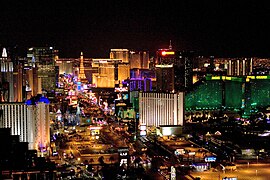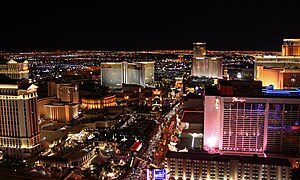
Las Vegas Strip
The Las Vegas Strip is a stretch of Las Vegas Boulevard in Clark County, Nevada, that is known for its concentration of resort hotels and casinos. The Strip, as it is known, is about 4.2 mi (6.8 km) long,[1] and is immediately south of the Las Vegas city limits in the unincorporated towns of Paradise and Winchester, but is often referred to simply as "Las Vegas".
"Vegas Strip" and "The Strip" redirect here. For other uses, see The Strip (disambiguation).Length
Many of the largest hotel, casino, and resort properties in the world are on the Strip, known for its contemporary architecture, lights, and wide variety of attractions. Its hotels, casinos, restaurants, residential high-rises, entertainment offerings, and skyline have established the Strip as one of the most popular and iconic tourist destinations in the world and is one of the driving forces for Las Vegas's economy.[2] Most of the Strip has been designated as an All-American Road,[3] and the North and South Las Vegas Strip routes are classified as Nevada Scenic Byways and National Scenic Byways.[4]
Transportation[edit]
Buses[edit]
RTC Transit (previously Citizens Area Transit, or CAT) provides bus service on the Strip with double decker buses known as The Deuce.[62] The Deuce runs between the Welcome to Fabulous Las Vegas sign and South Strip Transfer Terminal to the Bonneville Transit Center (BTC) and the Fremont Street Experience in Downtown Las Vegas, with stops near every casino.
Although the Strip has elaborate displays, fountains, and large buffet restaurants, many of the hotel resort properties are renowned for their sustainability efforts, including:[118][119]
Renewable energy is generated and used on the Strip.[118] MGM initiated solar power when it built a solar array on top of the Mandalay Bay in 2014 and expanded it in 2016.[118][120] The solar array at the Mandalay Bay, a 28-acre system capable of powering 1,300 homes, is one of the largest commercial rooftop solar arrays in the United States.[121] The solar array includes more than 26,000 solar panels capable of providing a total of 8.3 megawatts DC (6.5 megawatts AC), sufficient for powering 25% of the Mandalay Bay campus.[122]
Energy-efficient buildings are also being implemented and the Strip has one of the highest concentrations of LEED-certified buildings in the world.[118][123] Some examples of LEED-certified buildings are the Octavius Tower at Caesars Palace and the Linq Promenade, both of which are certified LEED Silver.[118]









